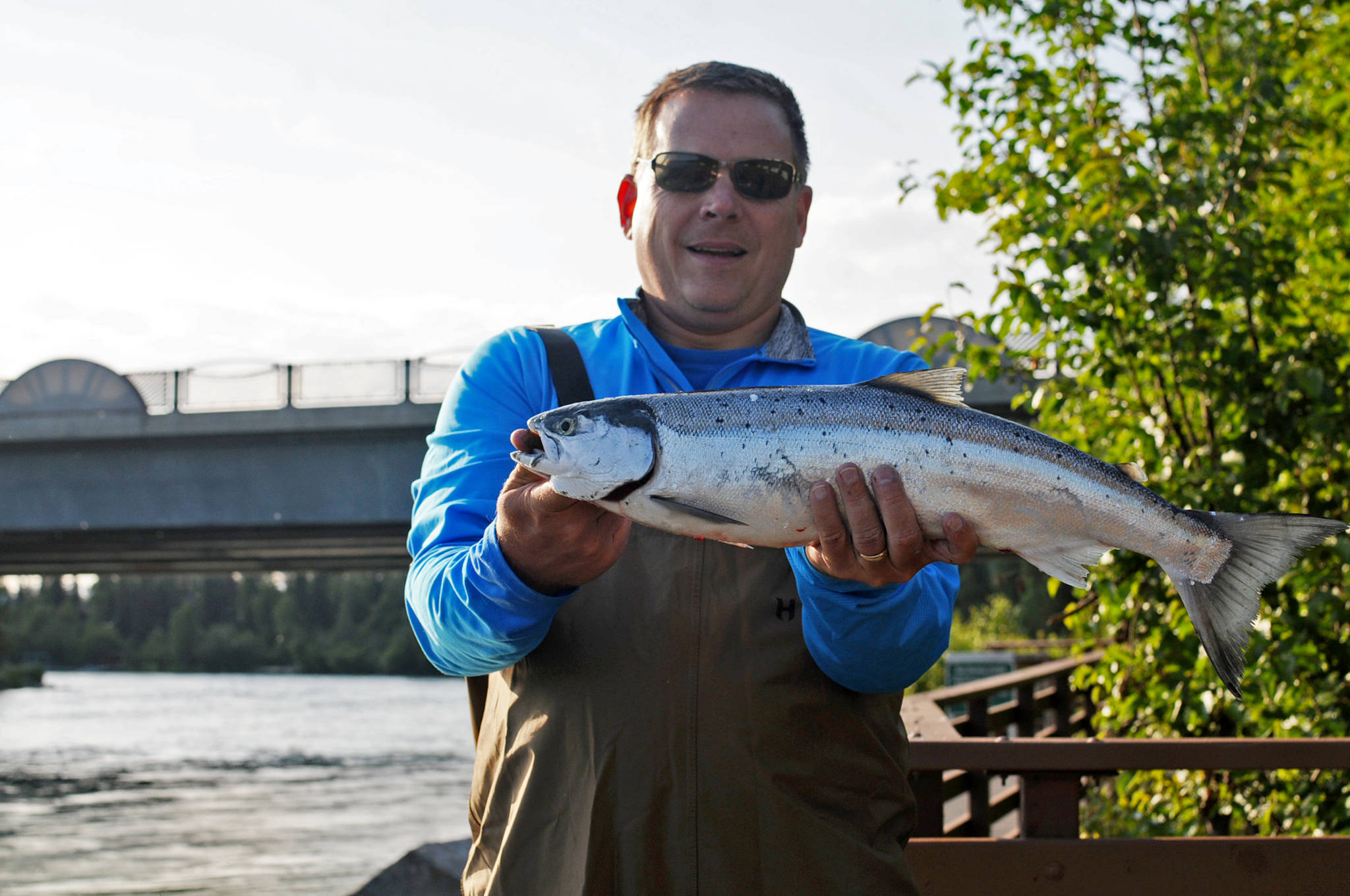Kenai River sockeye salmon are making their way up the river in growing numbers, though it’s still a little slow.
Tom Lyman, a Michigan resident visiting Alaska for the first time, landed his first Alaska sockeye on the shore near the Soldotna Visitor Center’s boardwalk Wednesday. A decent-length fish, he said he didn’t have to wait long before a bite that morning.
“We just got here, and literally, this was about 10 casts in,” he said.
Further down the river, though, fishing was slow. Other anglers said they weren’t having as much luck, and at the mouth, personal-use dipnetters were having mixed success. On Tuesday, some were able to pull half a dozen fish from the water in a few hours, while others pulled out empty nets.
The sockeye salmon runs that dominates July on the Kenai and Kasilof rivers are underway, but a little slower than in the last few years. With 104,275 sockeye having passed the Alaska Department of Fish and Game’s Kenai River sonar as of Tuesday and without a single day’s passage rate having exceeded 20,000 fish yet. The Kasilof River is nearly on par with 2016 so far, with 114,745 sockeye having passed the sonar as Tuesday, with daily passage rates typically between 2,000 and 6,000 fish.
It’s a little more typical of what longtime fishermen have seen on the Kenai, with the run starting off slower and peaking about the third week of July. Over the last few years, the runs have been fairly early, said Scott Miller, co-owner of Trustworthy Hardware and Fishing in Soldotna.
Some people are catching limits — which are three per day with six in possession on the Kenai River — and customers at Trustworthy can ask for advice on where to go and what gear to take, he said.
“If people have their spot and they know what they’re doing, they tend to be getting their fish,” he said. “If they come in, we can get them set up to do that.”
But king salmon are still the star of the show on the Kenai River, he said. Guides and anglers have been telling stories about good size late-run kings in the last few days, Miller said, particular on Tuesday, which is a major guided fishing day on the river. Fishermen have been having luck with kings biting on plugs, Miller said.
With a larger forecasted run of late-run kings, Fish and Game opened up the lower river to bait before the late-run season began on July 1. As of Monday, 3,119 large kings had passed the sonar, with daily passage rates around 300–400 fish per day since last Saturday. Anglers can retain any size fish and use bait on the Kenai between the mouth and Slikok Creek, but between Slikok Creek and Skilak Lake, they are still restricted to no bait and to only retaining fish less than 36 inches long. With only 10 days of data to assess the run so far, it’s hard to say whether the forecast is accurate, but it’s looking positive, said Jason Pawluk, the assistant area management biologist for the Division of Sportfish in Soldotna.
“The positive news that we’re seeing right now in our fishery is the Kenai River king salmon fishing, and the quality of fish has also been really good,” he said. “(In the sonar) we are seeing a good proportion of large king salmon this year, and that’s very nice to see. It’s being borne out in the fish that we’re sampling in the creel and in our netting.”
The Kasilof River, which has been productive for king salmon since early May, has finally started to slow down as the early run transitions to the late run, Pawluk said. However, some fish are still being caught, and large ones — Fish and Game sealed a trophy-size king salmon caught in the Kasilof on Tuesday, he said.
The Russian River fishery is transitioning between runs as well. A large early run of sockeye led Fish and Game to double the bag limit and open the sanctuary area to fishing. However, fishing has slowed down, and Fish and Game is getting reports that anglers are seeing darker early-run fish mixed with fresher late-run fish.
“The early run has dropped off,” he said. “…I think there’s if you’re dedicated, you can get some fish up there still.”
The early run will transition to the late run on Saturday, and Pawluk said Fish and Game will remind anglers that effective Saturday at midnight, the bag limit will revert from six fish per day with 12 in possession to three per day with six in possession, per the standard regulations. However, he said most effort will likely transition to the lower Kenai River as the mainstem sockeye begin returning in earnest.
Silver salmon are also reportedly being caught in Resurrection Bay near Seward, a popular silver salmon fishery. Last year, sportfishermen were puzzled by the poor silver salmon returns throughout the season, but this year charter guides have been reporting good success, according to Fish and Game’s weekly fishing report for the area. Miller said he’d talked to multiple charter captains and anglers headed for Seward who said silver fishing was good.
Halibut fishing is also warming up, too. Miller said anglers fishing for halibut from the beach had been having good success in the Kenai area recently.
“I just talked to a couple of people down there for halibut off the beach and they got limits here over the weekend,” he said.
Halibut fishermen in Homer are also having good success, and the top spot in the annual Homer halibut derby is up to 229 pounds. Dominique Brooks of Maryville, Tenn. landed the fish on June 16, according to an update from the Homer Chamber of Commerce, which coordinates the derby.
Reach Elizabeth Earl at elizabeth.earl@peninsulaclarion.com.

